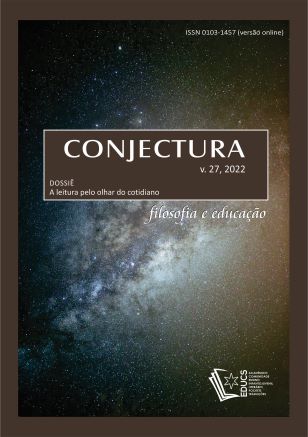The photographic discourse between the doxa and the paradox
DOI:
https://doi.org/10.18226/21784612.v27.e022002Keywords:
Erudite lecture/popular Reading, Plural objects/history of photography.Abstract
Photographic discourse between doxa and paradoxe appearing in 1839 as a technical process of representation of the image, in the amateur and enlightenment middle, Photography will produce a popular speech that will be exclusive for almost three decades: the photographic image is beautiful more perfect it is as an imitation of the reality. Clear and with formal information about time and space. This popular speech includes a short historical information about some authors of technical inventions that improved fixation and circulation image. In the last quarter of that century, as a sensibleness against Industrial making, amateur photographs define an artistic and creative sight supported with a photographic theory, the Pictorialism, that overvalues the creative subject coinciding with new forms of Thought and Art. When Pictorialism is exhausted after the 1st G. War, a new sight which includes the ability of the new camera to mimic cinema effects, the subjective sight will no longer abandon the photographic practice while the photographic literature multiplies itself with the interest of philosophers, thinkers, film makers, psychologists and psychiatrists since the developing of the mass society. In the last quarter of the XX century, with post-modern inspiration, it appears as an international pattern a new History of Photography treated as History of Art, with styles and authors, that still remains. The objective of this work is to distinguish popular and scholarly photographic reading from its origins to the technological revolution that provokes a real crisis through the analysis of its greatest analysts. Taking into consideration our time, a period of numeric change, facing the new computational technology, that work with algoritms, image reading must change, but photographs and analysts repeat analog concept and strategies.
References
ARNHEIM, Rudolf, 1974, in Ensaios sobre Fotografia de Nièpce a Kraus, p. 149–161 org. Alan Trachtenberg, 2013, Orfeu Negro, Lisboa.
BARTHES, François, 1998, A câmara clara, Edições 70, Lisboa.
BARTHES, Roland,1982, La rethorique de l’image in L’obvie et l’obtus, Essais III, Seuil, Paris.
BAUMAN, Zygmund, 2012, Ensaios, Jorge Zahar, Ed, Rio de Janeiro.
BAZIN, André, 1945, Ontologie de l’image photographique in Qu’est-ce que le cinema? Paris, Ed. Du Cerf, 1975.
BENJAMIN, W. Magia, arte e técnica: ensaios sobre a literatura e história da cultura. São Paulo: Brasiliense, 1985.Obras Escolhidas, v.1.
CHÂTELET, François, 1997, História da Filosofia. O Século XX, Postfacio, Don Quixote, Lisboa.
DELEUZE, G., GUATTARI, 1992, O que é a Filosofia? Presença, Lisboa.
DIDI-Huberman, Georges, 2008, Imagens de lamentação, imagens lamentáveis, in Revista de Comunicação e Linguagens, p. 63–74, Lisboa.
DURAND, Régis, 1997, Lo que no puede ser visto, in Papel Alpha, nº 3, Salamanca.
DURAND, Régis, 1995, Le temps de l’image, Essai sur les conditions d’une histoire des formes photographiques, La Difference, Paris.
FLUSSER, Vilém, 2001, Una filosofia de la fotografia, Editorial Síntisis, Madrid.
FOUCAULT, Michel, 2006, O que é um autor?, Nova Veja/Passagens, Lisboa.
KRAUS, Rosalind, 1985, Photoghraphy’s Discursing Spaces, in The Originality of the Avant-Garde and other Modernist Myths, 131–150 MIT Press, Cambridge.
GIL, José, 2020, A pandemia e o capitalismo numérico, jornal Público, 13 de abril.
PERNIOLA, Mário, 2000, Enigmas, o Momento Egípcio na Sociedade e na Arte, Bertrand Editores, Lisboa.
RITCHIN, Fred, 2010, After photography, Ed. Norton, NY/London.
SEKULA, Allan, 1984, Sobre a invenção do significado da fotografia, in Ensaios sobre fotografia,1913, p. 387–409.
SONTAG, Susan, 1977, On photography, N.Y.
VATTIMO, Gianni, 1992, The transparente Society, Baltimore Univ. J. Hopkins, p. 117.
VIRILIO, Paul, 1997, Un monde super exposé fin de l’histoire ou fin de la geographie?, in Le Monde Diplomatique, agosto 1997, p. 17.
TISSERON, Serge, 1996, La imagen funambula, o la sensacion en fotografia, in Papel Alpha nº 2; 2000, El mistério de la cámara lúcida, Papel Alpha nº 4, Salamanca.
Downloads
Published
How to Cite
Issue
Section
License
1. The publication of the originals will imply the assignment of copyright to Conjectura Journal.
2. Texts cannot be reproduced without authorization from the Journal after acceptance.









